Target Information
| Target General Information | Top | |||||
|---|---|---|---|---|---|---|
| Target ID |
T07087
(Former ID: TTDI02472)
|
|||||
| Target Name |
Focal adhesion kinase 2 (PTK2B)
|
|||||
| Synonyms |
Related adhesion focal tyrosine kinase; RAFTK; Protein-tyrosine kinase 2-beta; Proline-rich tyrosine kinase 2; PYK2; FAK2; FADK 2; Cell adhesion kinase beta; Calcium-regulated non-receptor proline-rich tyrosine kinase; Calcium-dependent tyrosine kinase; CAKB; CAK-beta; CADTK
Click to Show/Hide
|
|||||
| Gene Name |
PTK2B
|
|||||
| Target Type |
Literature-reported target
|
[1] | ||||
| Function |
Plays a role in the regulation of the humoral immune response, and is required for normal levels of marginal B-cells in the spleen and normal migration of splenic B-cells. Required for normal macrophage polarization and migration towards sites of inflammation. Regulates cytoskeleton rearrangement and cell spreading in T-cells, and contributes to the regulation of T-cell responses. Promotes osteoclastic bone resorption; this requires both PTK2B/PYK2 and SRC. May inhibit differentiation and activity of osteoprogenitor cells. Functions in signaling downstream of integrin and collagen receptors, immune receptors, G-protein coupled receptors (GPCR), cytokine, chemokine and growth factor receptors, and mediates responses to cellular stress. Forms multisubunit signaling complexes with SRC and SRC family members upon activation; this leads to the phosphorylation of additional tyrosine residues, creating binding sites for scaffold proteins, effectors and substrates. Regulates numerous signaling pathways. Promotes activation of phosphatidylinositol 3-kinase and of the AKT1 signaling cascade. Promotes activation of NOS3. Regulates production of the cellular messenger cGMP. Promotes activation of the MAP kinase signaling cascade, including activation of MAPK1/ERK2, MAPK3/ERK1 and MAPK8/JNK1. Promotes activation of Rho family GTPases, such as RHOA and RAC1. Recruits the ubiquitin ligase MDM2 to P53/TP53 in the nucleus, and thereby regulates P53/TP53 activity, P53/TP53 ubiquitination and proteasomal degradation. Acts as a scaffold, binding to both PDPK1 and SRC, thereby allowing SRC to phosphorylate PDPK1 at 'Tyr-9, 'Tyr-373', and 'Tyr-376'. Promotes phosphorylation of NMDA receptors by SRC family members, and thereby contributes to the regulation of NMDA receptor ion channel activity and intracellular Ca(2+) levels. May also regulate potassium ion transport by phosphorylation of potassium channel subunits. Phosphorylates SRC; this increases SRC kinase activity. Phosphorylates ASAP1, NPHP1, KCNA2 and SHC1. Promotes phosphorylation of ASAP2, RHOU and PXN; this requires both SRC and PTK2/PYK2. Non-receptor protein-tyrosine kinase that regulates reorganization of the actin cytoskeleton, cell polarization, cell migration, adhesion, spreading and bone remodeling.
Click to Show/Hide
|
|||||
| BioChemical Class |
Kinase
|
|||||
| UniProt ID | ||||||
| EC Number |
EC 2.7.10.2
|
|||||
| Sequence |
MSGVSEPLSRVKLGTLRRPEGPAEPMVVVPVDVEKEDVRILKVCFYSNSFNPGKNFKLVK
CTVQTEIREIITSILLSGRIGPNIRLAECYGLRLKHMKSDEIHWLHPQMTVGEVQDKYEC LHVEAEWRYDLQIRYLPEDFMESLKEDRTTLLYFYQQLRNDYMQRYASKVSEGMALQLGC LELRRFFKDMPHNALDKKSNFELLEKEVGLDLFFPKQMQENLKPKQFRKMIQQTFQQYAS LREEECVMKFFNTLAGFANIDQETYRCELIQGWNITVDLVIGPKGIRQLTSQDAKPTCLA EFKQIRSIRCLPLEEGQAVLQLGIEGAPQALSIKTSSLAEAENMADLIDGYCRLQGEHQG SLIIHPRKDGEKRNSLPQIPMLNLEARRSHLSESCSIESDIYAEIPDETLRRPGGPQYGI AREDVVLNRILGEGFFGEVYEGVYTNHKGEKINVAVKTCKKDCTLDNKEKFMSEAVIMKN LDHPHIVKLIGIIEEEPTWIIMELYPYGELGHYLERNKNSLKVLTLVLYSLQICKAMAYL ESINCVHRDIAVRNILVASPECVKLGDFGLSRYIEDEDYYKASVTRLPIKWMSPESINFR RFTTASDVWMFAVCMWEILSFGKQPFFWLENKDVIGVLEKGDRLPKPDLCPPVLYTLMTR CWDYDPSDRPRFTELVCSLSDVYQMEKDIAMEQERNARYRTPKILEPTAFQEPPPKPSRP KYRPPPQTNLLAPKLQFQVPEGLCASSPTLTSPMEYPSPVNSLHTPPLHRHNVFKRHSMR EEDFIQPSSREEAQQLWEAEKVKMRQILDKQQKQMVEDYQWLRQEEKSLDPMVYMNDKSP LTPEKEVGYLEFTGPPQKPPRLGAQSIQPTANLDRTDDLVYLNVMELVRAVLELKNELCQ LPPEGYVVVVKNVGLTLRKLIGSVDDLLPSLPSSSRTEIEGTQKLLNKDLAELINKMRLA QQNAVTSLSEECKRQMLTASHTLAVDAKNLLDAVDQAKVLANLAHPPAE Click to Show/Hide
|
|||||
| 3D Structure | Click to Show 3D Structure of This Target | AlphaFold | ||||
| HIT2.0 ID | T03VS9 | |||||
| Cell-based Target Expression Variations | Top | |||||
|---|---|---|---|---|---|---|
| Cell-based Target Expression Variations | ||||||
| Drug Binding Sites of Target | Top | |||||
|---|---|---|---|---|---|---|
| Ligand Name: PF-562271 | Ligand Info | |||||
| Structure Description | Selectivity switch between FAK and Pyk2: Macrocyclization of FAK inhibitors improves Pyk2 potency | PDB:5TOB | ||||
| Method | X-ray diffraction | Resolution | 2.12 Å | Mutation | No | [3] |
| PDB Sequence |
IAREDVVLNR
429 ILGEGFFGEV439 YEGVYTHKGE450 KINVAVKTCK460 DNKEKFMSEA475 VIMKNLDHPH 485 IVKLIGIIEP497 TWIIMELYPY507 GELGHYLERN517 KNSLKVLTLV527 LYSLQICKAM 537 AYLESINCVH547 RDIAVRNILV557 ASPECVKLGD567 FGPIKWMSPE595 SINFRRFTTA 605 SDVWMFAVCM615 WEILSFGKQP625 FFWLENKDVI635 GVLEKGDRLP645 KPDLCPPVLY 655 TLMTRCWDYD665 PSDRPRFTEL675 VCSLSDVYQM685 EKDIA
|
|||||
|
|
LEU431
3.590
GLY432
2.989
GLU433
3.214
GLY434
4.163
VAL439
3.650
ALA455
4.036
LYS457
4.357
VAL487
3.438
LYS488
4.988
MET502
3.379
GLU503
3.177
|
|||||
| Ligand Name: Doramapimod | Ligand Info | |||||
| Structure Description | Crystal Structure of PYK2 complexed with BIRB796 | PDB:3FZS | ||||
| Method | X-ray diffraction | Resolution | 1.75 Å | Mutation | No | [4] |
| PDB Sequence |
IAREDVVLNR
429 ILGEGFFGEV439 YEGVYTNHKG449 EKINVAVKTC459 KKDCTLDNKE469 KFMSEAVIMK 479 NLDHPHIVKL489 IGIIEEEPTW499 IIMELYPYGE509 LGHYLERNKN519 SLKVLTLVLY 529 SLQICKAMAY539 LESINCVHRD549 IAVRNILVAS559 PECVKLGDFG569 LPIKWMSPES 596 INFRRFTTAS606 DVWMFAVCMW616 EILSFGKQPF626 FWLENKDVIG636 VLEKGDRLPK 646 PDLCPPVLYT656 LMTRCWDYDP666 SDRPRFTELV676 CSLSDVYQME686 KDIA |
|||||
|
|
LEU431
3.832
VAL439
4.074
ALA455
3.837
LYS457
4.088
LYS470
4.332
SER473
3.639
GLU474
2.756
ILE477
3.919
MET478
3.640
LEU481
3.229
ILE486
4.045
VAL487
3.462
|
|||||
| Click to View More Binding Site Information of This Target with Different Ligands | ||||||
| Different Human System Profiles of Target | Top |
|---|---|
|
Human Similarity Proteins
of target is determined by comparing the sequence similarity of all human proteins with the target based on BLAST. The similarity proteins for a target are defined as the proteins with E-value < 0.005 and outside the protein families of the target.
A target that has fewer human similarity proteins outside its family is commonly regarded to possess a greater capacity to avoid undesired interactions and thus increase the possibility of finding successful drugs
(Brief Bioinform, 21: 649-662, 2020).
Human Tissue Distribution
of target is determined from a proteomics study that quantified more than 12,000 genes across 32 normal human tissues. Tissue Specificity (TS) score was used to define the enrichment of target across tissues.
The distribution of targets among different tissues or organs need to be taken into consideration when assessing the target druggability, as it is generally accepted that the wider the target distribution, the greater the concern over potential adverse effects
(Nat Rev Drug Discov, 20: 64-81, 2021).
Human Pathway Affiliation
of target is determined by the life-essential pathways provided on KEGG database. The target-affiliated pathways were defined based on the following two criteria (a) the pathways of the studied target should be life-essential for both healthy individuals and patients, and (b) the studied target should occupy an upstream position in the pathways and therefore had the ability to regulate biological function.
Targets involved in a fewer pathways have greater likelihood to be successfully developed, while those associated with more human pathways increase the chance of undesirable interferences with other human processes
(Pharmacol Rev, 58: 259-279, 2006).
Biological Network Descriptors
of target is determined based on a human protein-protein interactions (PPI) network consisting of 9,309 proteins and 52,713 PPIs, which were with a high confidence score of ≥ 0.95 collected from STRING database.
The network properties of targets based on protein-protein interactions (PPIs) have been widely adopted for the assessment of target’s druggability. Proteins with high node degree tend to have a high impact on network function through multiple interactions, while proteins with high betweenness centrality are regarded to be central for communication in interaction networks and regulate the flow of signaling information
(Front Pharmacol, 9, 1245, 2018;
Curr Opin Struct Biol. 44:134-142, 2017).
Human Similarity Proteins
Human Tissue Distribution
Human Pathway Affiliation
Biological Network Descriptors
|
|
|
Note:
If a protein has TS (tissue specficity) scores at least in one tissue >= 2.5, this protein is called tissue-enriched (including tissue-enriched-but-not-specific and tissue-specific). In the plots, the vertical lines are at thresholds 2.5 and 4.
|
| KEGG Pathway | Pathway ID | Affiliated Target | Pathway Map |
|---|---|---|---|
| Calcium signaling pathway | hsa04020 | Affiliated Target |
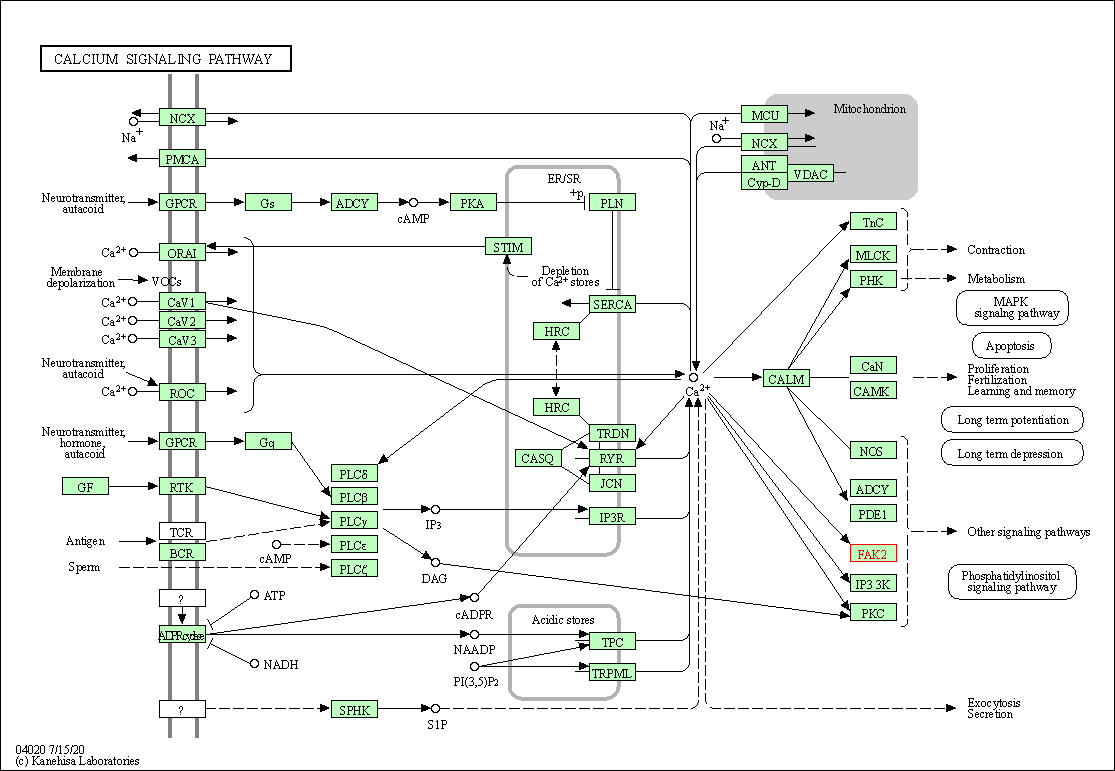
|
| Class: Environmental Information Processing => Signal transduction | Pathway Hierarchy | ||
| Chemokine signaling pathway | hsa04062 | Affiliated Target |
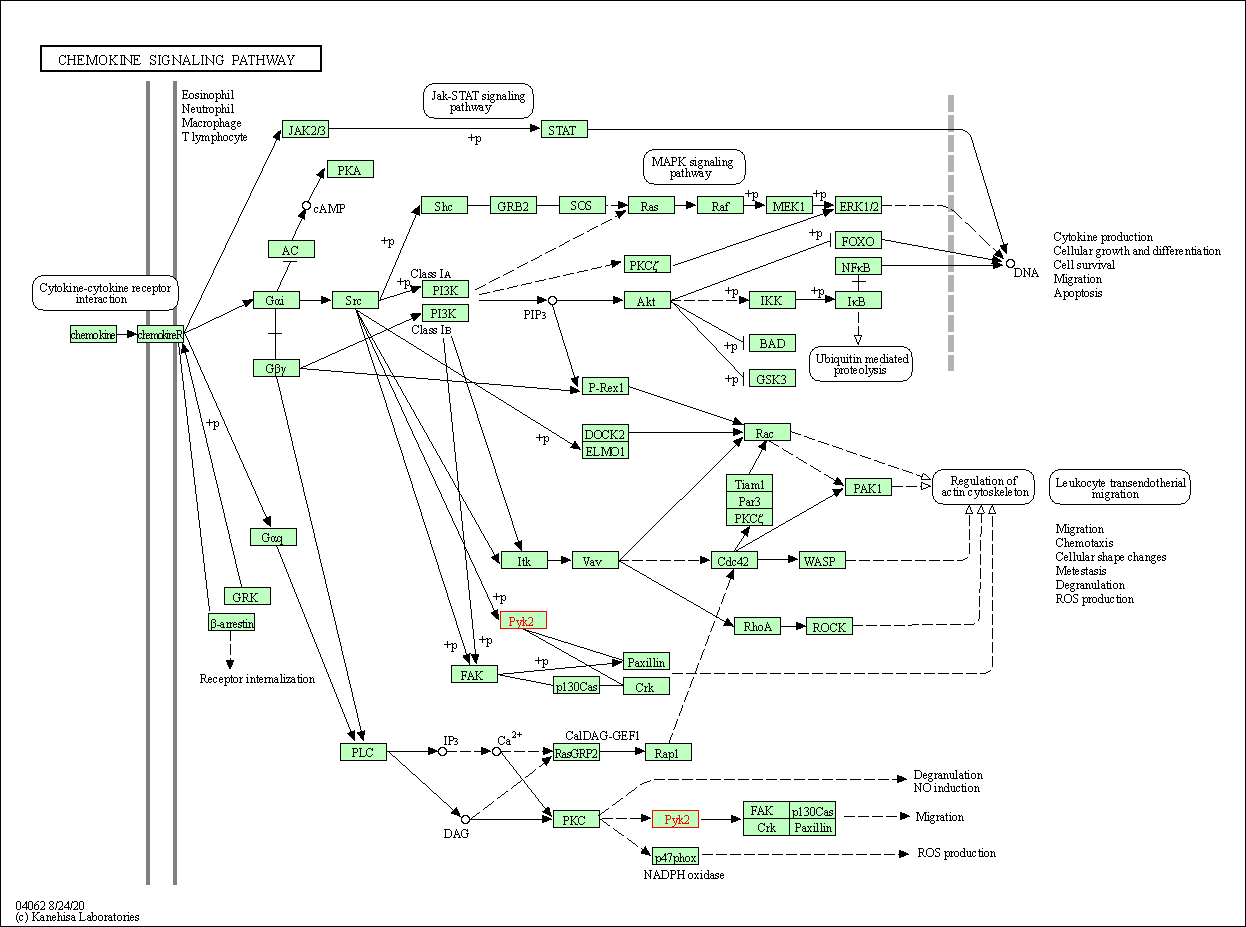
|
| Class: Organismal Systems => Immune system | Pathway Hierarchy | ||
| Phospholipase D signaling pathway | hsa04072 | Affiliated Target |
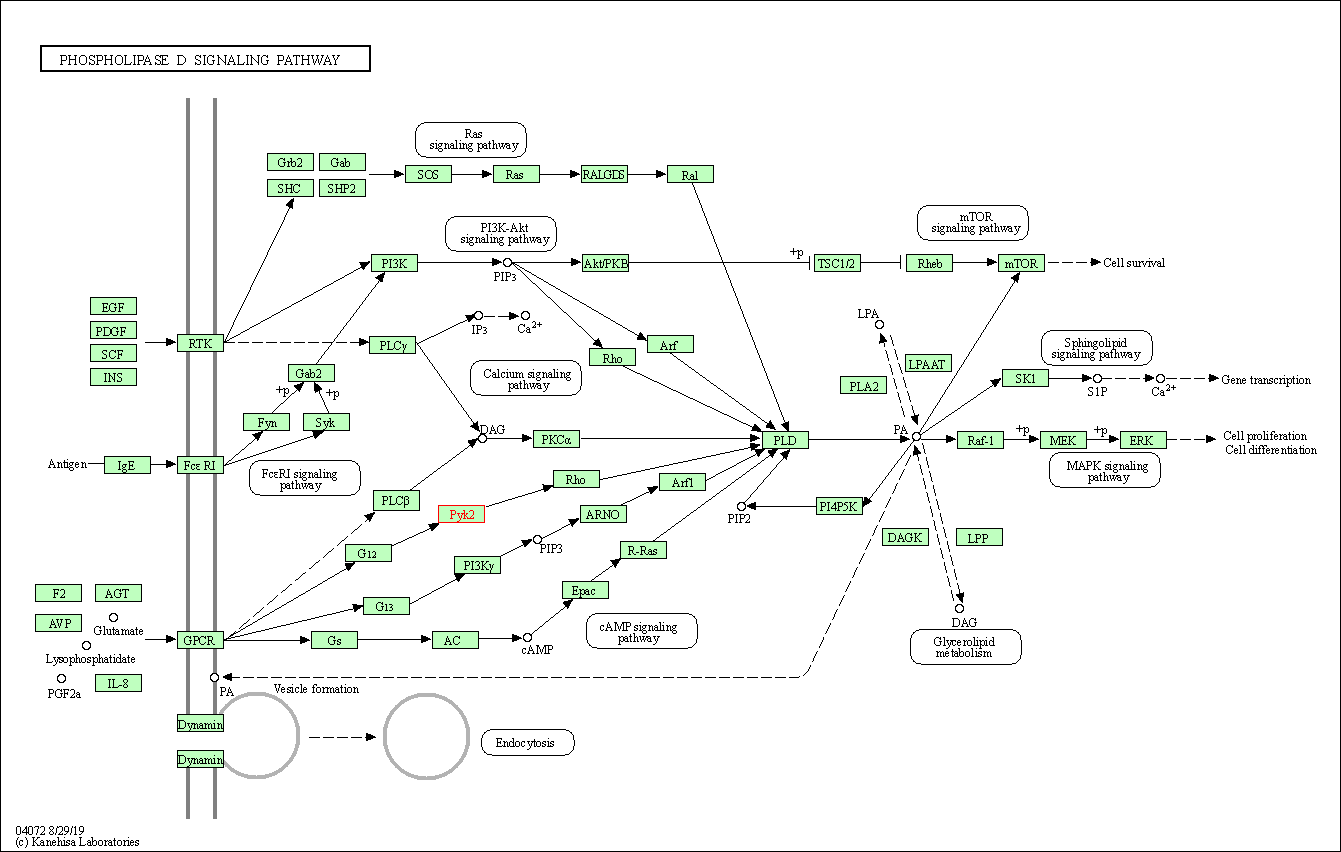
|
| Class: Environmental Information Processing => Signal transduction | Pathway Hierarchy | ||
| Natural killer cell mediated cytotoxicity | hsa04650 | Affiliated Target |
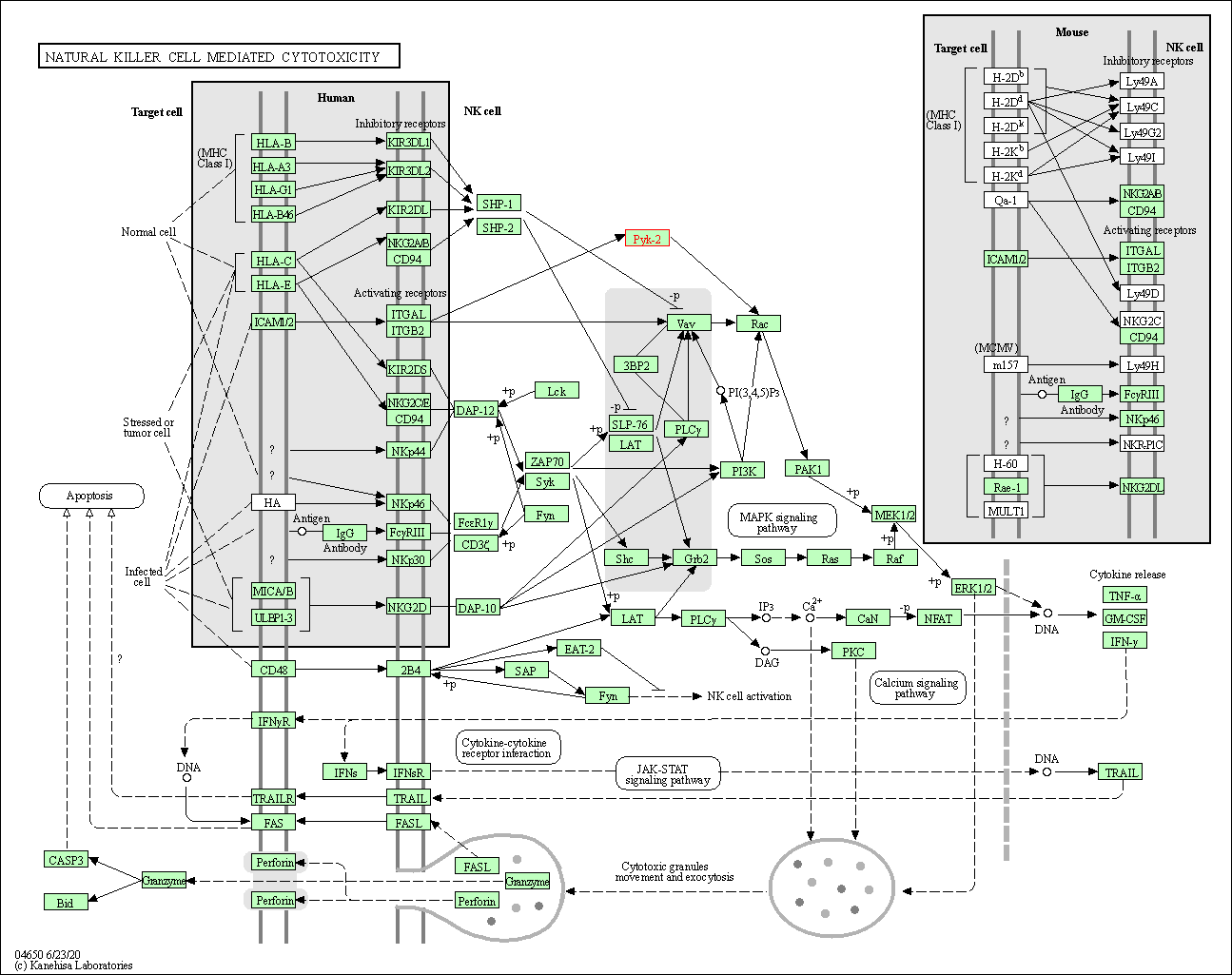
|
| Class: Organismal Systems => Immune system | Pathway Hierarchy | ||
| Leukocyte transendothelial migration | hsa04670 | Affiliated Target |
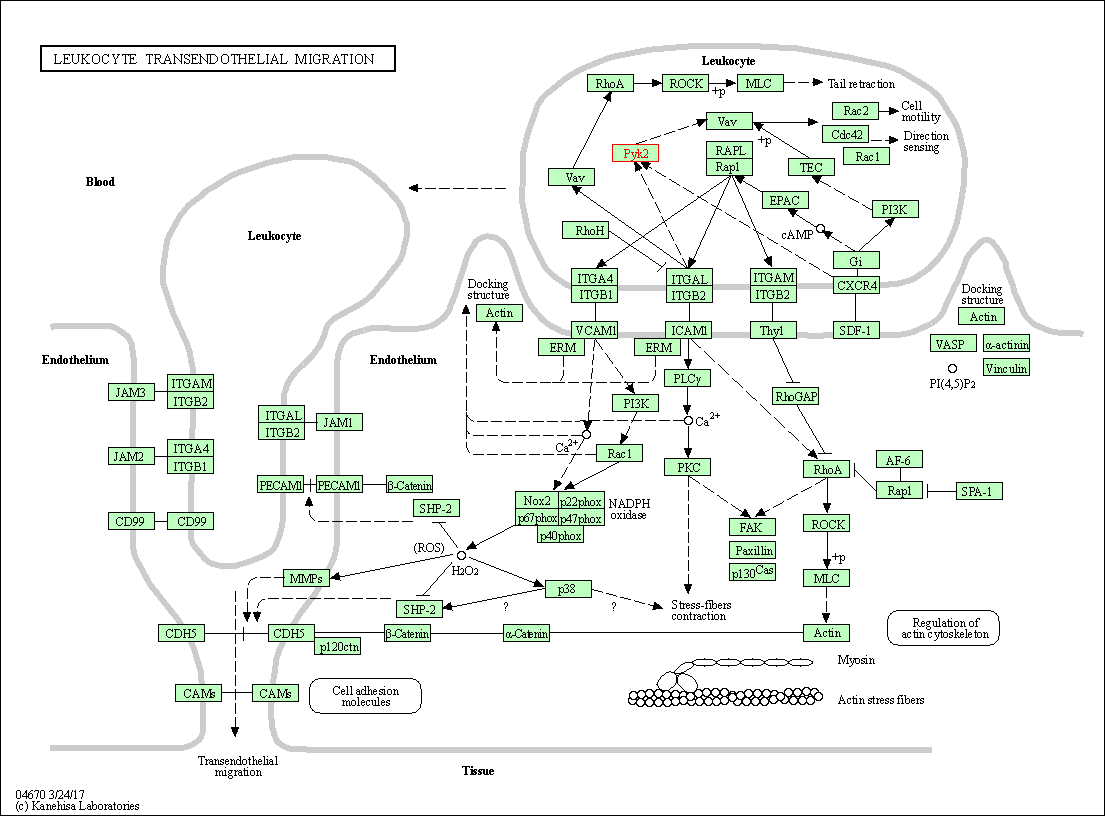
|
| Class: Organismal Systems => Immune system | Pathway Hierarchy | ||
| GnRH signaling pathway | hsa04912 | Affiliated Target |
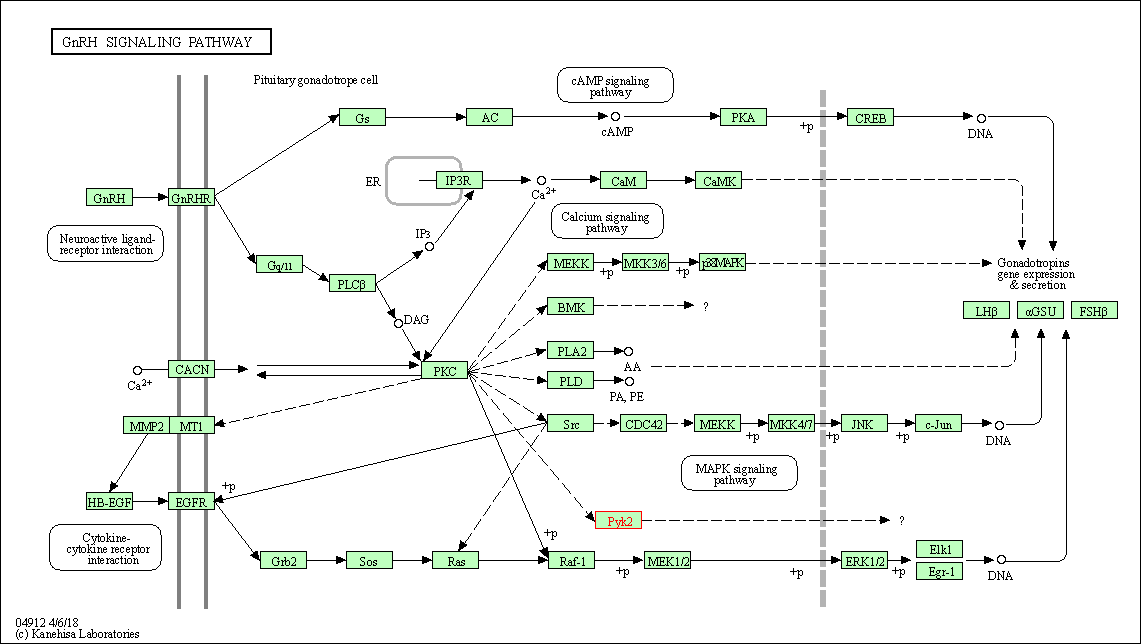
|
| Class: Organismal Systems => Endocrine system | Pathway Hierarchy | ||
| Click to Show/Hide the Information of Affiliated Human Pathways | |||
| Degree | 18 | Degree centrality | 1.93E-03 | Betweenness centrality | 9.55E-04 |
|---|---|---|---|---|---|
| Closeness centrality | 2.40E-01 | Radiality | 1.42E+01 | Clustering coefficient | 3.79E-01 |
| Neighborhood connectivity | 6.34E+01 | Topological coefficient | 1.22E-01 | Eccentricity | 12 |
| Download | Click to Download the Full PPI Network of This Target | ||||
| Chemical Structure based Activity Landscape of Target | Top |
|---|---|
| Target Poor or Non Binders | Top | |||||
|---|---|---|---|---|---|---|
| Target Poor or Non Binders | ||||||
| Target Regulators | Top | |||||
|---|---|---|---|---|---|---|
| Target-regulating microRNAs | ||||||
| Target-interacting Proteins | ||||||
| References | Top | |||||
|---|---|---|---|---|---|---|
| REF 1 | URL: http://www.guidetopharmacology.org Nucleic Acids Res. 2015 Oct 12. pii: gkv1037. The IUPHAR/BPS Guide to PHARMACOLOGY in 2016: towards curated quantitative interactions between 1300 protein targets and 6000 ligands. (Target id: 2181). | |||||
| REF 2 | Identification of binding specificity-determining features in protein families. J Med Chem. 2012 Mar 8;55(5):1926-39. | |||||
| REF 3 | Selectivity switch between FAK and Pyk2: Macrocyclization of FAK inhibitors improves Pyk2 potency. Bioorg Med Chem Lett. 2016 Dec 15;26(24):5926-5930. | |||||
| REF 4 | Structural characterization of proline-rich tyrosine kinase 2 (PYK2) reveals a unique (DFG-out) conformation and enables inhibitor design. J Biol Chem. 2009 May 8;284(19):13193-201 | |||||
If You Find Any Error in Data or Bug in Web Service, Please Kindly Report It to Dr. Zhou and Dr. Zhang.

